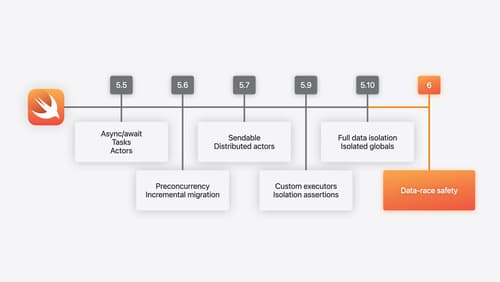how should I prepare my app for swift 6?
Asked on 2024-08-12
1 search
To prepare your app for Swift 6, you should follow a structured migration process. Here are the key steps:
-
Enable Complete Concurrency Checking: Start by enabling complete concurrency checking in your project. This is a per-module setting that allows your project to remain in Swift 5 mode while generating warnings for code that would fail under Swift 6's enforced data isolation. This step helps you identify and resolve potential data race issues.
-
Resolve Warnings: Go through the warnings generated by the concurrency checking and resolve them. This process involves making necessary code changes to ensure data race safety.
-
Enable Swift 6 Mode: Once all warnings are resolved for a module, enable Swift 6 mode for that module. This locks in your changes and ensures that future modifications do not introduce unsafe code.
-
Incremental Migration: Migrate your app incrementally, one module at a time. This approach allows you to manage the transition smoothly without waiting for all dependencies to migrate.
-
Utilize Compiler Diagnostics: The Swift 6 compiler provides diagnostics that guide you towards areas in your code that need fixing. Think of it as a pair programmer helping you identify potential bugs.
-
Adopt New Features: Consider adopting new concurrency features and other improvements introduced in Swift 6 to enhance your app's performance and responsiveness.
For more detailed guidance, you can refer to the session Migrate your app to Swift 6 (07:26) which covers the strategy for migration.
Additionally, the session Platforms State of the Union (31:22) discusses the benefits of the new Swift 6 language mode, including compile-time data race safety.
By following these steps, you can ensure a smooth transition to Swift 6 while taking advantage of its new features and improvements.

Migrate your app to Swift 6
Experience Swift 6 migration in action as we update an existing sample app. Learn how to migrate incrementally, module by module, and how the compiler helps you identify code that’s at risk of data races. Discover different techniques for ensuring clear isolation boundaries and eliminating concurrent access to shared mutable state.

What’s new in Swift
Join us for an update on Swift. We’ll briefly go through a history of Swift over the past decade, and show you how the community has grown through workgroups, expanded the package ecosystem, and increased platform support. We’ll introduce you to a new language mode that achieves data-race safety by default, and a language subset that lets you run Swift on highly constrained systems. We’ll also explore some language updates including noncopyable types, typed throws, and improved C++ interoperability.

Platforms State of the Union
Discover the newest advancements on Apple platforms.
